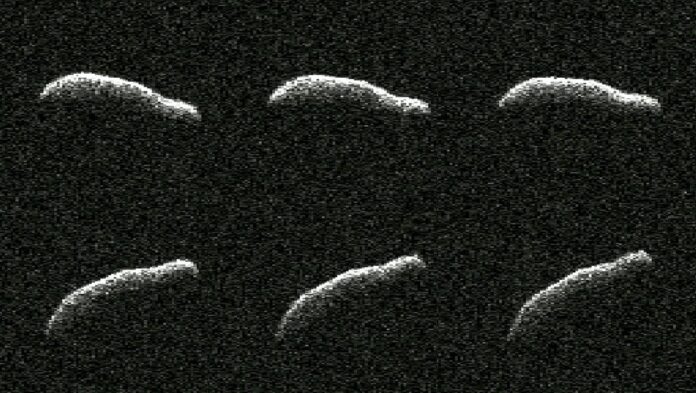NASA managed to image an asteroid larger than the Empire State Building and with similar proportions as it hurtled past Earth at the beginning of February, 2023.
The asteroid, designated 2011 AG5, passed safely past our planet at a distance of around 1.1 million miles (1.8 million kilometers), about five times the distance between Earth and the moon. But, while it posed no danger of impacting our planet, the asteroid could actually still have a big scientific impact.
The close approach allowed scientists at NASA’s Jet Propulsion Laboratory (JPL) in Southern California to track the space rock, and make invaluable observations to help determine its size, rotation, surface details, and, most notably, shape.
Related: Asteroid apocalypse: How big must a space rock be to end human civilization?
This opportunity, the first allowing astronomers to take such a close look at 2011 AG5 since its discovery in 2011, revealed the asteroid to be about 1,600 feet (500 meters) long and about 500 feet (150 m) wide. This means that the asteroid is extremely elongated.
At just over three times as long as it is wide, the asteroid has surprisingly similar proportions to the Empire State Building, one of the New York skyline’s most striking sights.
“Of the 1,040 near-Earth objects observed by planetary radar to date, this is one of the most elongated we’ve seen,” principal scientist at JPL, Lance Benner, who led the observations, said in a statement. (opens in new tab)
The observations were collected with the 230-foot (70 m) Goldstone Solar System Radar antenna dish at the Deep Space Network’s facility near Barstow, California, between Jan. 29 and Feb. 4, this year.
The telescope captured several other characteristics of 2011 AG5 including a concave dent in one of the asteroid’s two hemispheres. The asteroid also possesses subtle dark and light regions that could indicate small surface features just a few meters in diameter. Despite these variations in shade, the asteroid would appear charcoal dark if viewed with the human eye.
The research team was also able to determine that 2011 AG5 rotates slowly, taking around 9 hours to complete a full turn.
The Goldstone observations also give astronomers at JPL’s Center for Near Earth Object Studies (CNEOs) a better idea of the trajectory of the space rocks, which takes 621 Earth days to orbit the sun.
The asteroid 2011 AG5 was the focus of a great deal of attention shortly after its discovery as it was suspected to have a small chance of impacting Earth in 2040.
“Interestingly, shortly after its discovery, 2011 AG5 became a poster-child asteroid when our analysis showed it had a small chance of a future impact,” director for CNEOS at JPL Paul Chodas, said in the statement. “Continued observations of this object ruled out any chance of impact, and these new ranging measurements by the planetary radar team will further refine exactly where it will be far into the future.”
While 2011 AG5 won’t hit Earth in 2040, the asteroid will be back for another close approach, during which it will get even closer, passing our planet at a distance of around 670,000 miles (1.1 million kilometers) about three times the Earth-Moon distance
Follow us on Twitter @Spacedotcom or on Facebook.

